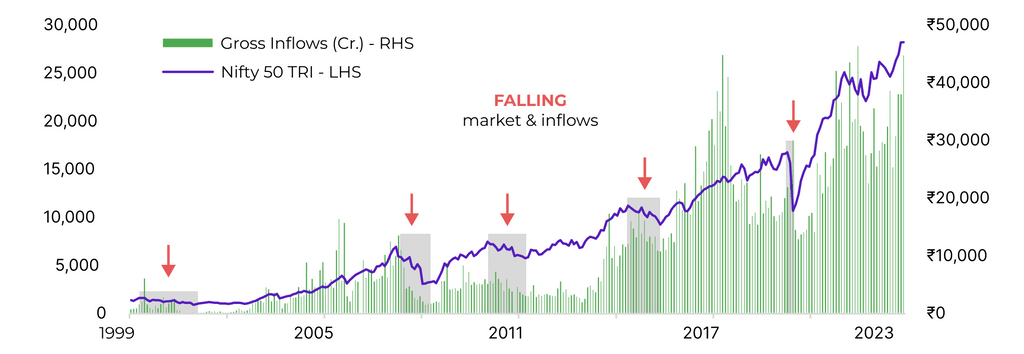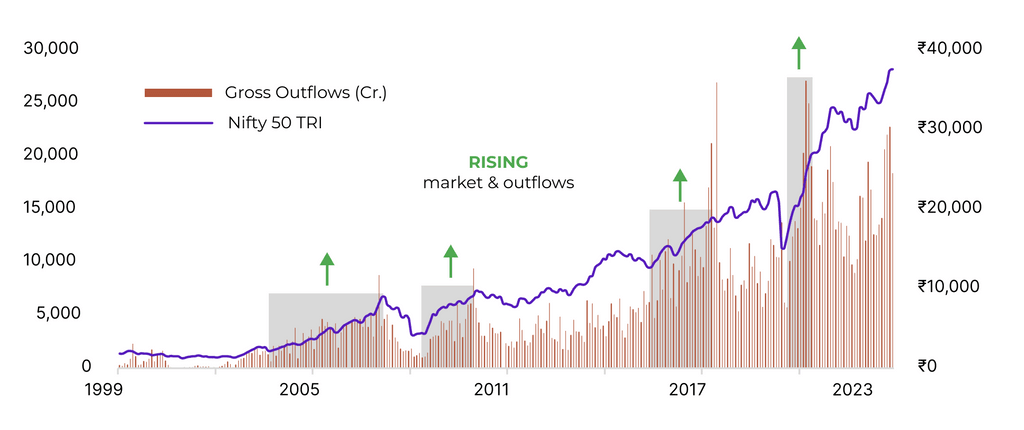
Are investors ‘Buying Low’ and ‘Selling High’?
What if we tell you that wildfires are necessary? It may seem outrageous, but ecologists have been learning the role of wildfires for a healthy ecosystem in recent times. It’s true that wildfires burn forests down causing immense damage and destruction to the environment. However, we’ve come to realise that they are also an essential part of nature’s cycles that helps the fittest survive and the inefficient to be weeded out.
Now what if we tell you that market crashes are essential? Akin to a wildfire, a market crash can be seen as a cleansing process that eliminates the weak and inefficient players. They create opportunities for efficient businesses that put to good use the capital invested in them. This ultimately helps restore the health and efficiency of capital markets allowing them to prosper further.
But as an investor, there are certain traits that have historically kept most investors from taking advantage of such opportunities. You ask how?
Staying put, but to get out.
Over the past 24 years, we have seen multiple crashes hit the equity markets. What we wanted to know was how individuals invest during periods of volatility.
We considered Nifty 50 TRI as the benchmark to identify instances of market upheaval and we took the net flows in mutual funds as a marker to understand investor behaviour. We did the analysis starting from October 1999 as we have benchmark data from that point in time.
What is it that you expect investors would do during market downturns?
The universal advice is to “Buy Low and Sell High”. Now a market crash means a “Low” and what you should be doing is “Buy”-ing. But instead, what we observed from the data was different.
In place of the buying which was supposed to happen during phases of market downturn, we see that the inflows fell from the previous pre-market crash trends.
On the other hand, people did not forget to sell at a “High”. Technically, it is a market high when the benchmark recovers to the pre-crash levels or even goes beyond it. However, have we been interpreting the universal proverb correctly? Have the markets not made a “higher-high” post the proverbial “high”?
Are we missing something?
What would have happened if you bought just before the market crash and sold it as soon as it recovered to the pre-crash high? It would basically be zero, right? No gain, no loss!
Now imagine a scenario if one hadn’t sold their investments post the recovery? Still, they would have ended up with a “No gain, no loss” scenario. However, the only difference here is that you wouldn’t have realised the loss, whereas in the former case you are ending up doing it. The question here to be asked is what were the potential gains that one could have earned had they not ended up “selling at a high”?
Let us consider a case wherein one would have done a monthly SIP every month in the benchmark for 10 years, there would have been a greater than 9 in 10 chance that you would have ended up with a return greater than 10% annualised return. Even in cases where the returns were less than 10%, it ended up being greater than 10%, if you continued investing through SIP for one more year.
But why does this happen?
It’s easy to say that we should continue to invest in markets when something severe happens. However, in reality no matter what one’s logical mind might say to them, the fear of their hard-earned money going down the drain can make many take irrational decisions such as stopping your investments and redeeming when it’s back to pre-market-fall levels. We’ve seen it through the flow of money, time and again over the last couple of decades.
What to do to stay rational?
One needs to follow a very process-oriented approach to avoid the pitfalls of what most do during testing times by the market.
1) If your goal is still 3-5 years away, then just stay away from news and sources that talk about the doom and gloom in the market at all and continue investing as you have already been doing.
2) Check if your determined asset allocation has gone out of balance due to the market fall. If yes, then rebalance it which automatically results in you taking advantage of the market fall rather than doing the opposite.
Just following these two steps are enough to bring about a change in mindset and stand apart from the herd. Because if you can do it once, it wouldn’t take much time to realise that market bottoms are in fact opportunities that are disguised with feelings of fear and anxiety. They provide the stones to build the foundation for future gains.
And in case you have been investing with us and are a regular reader of our research, then you can bank upon us to help you make the right choices during times of market distress.
Now it’s up to you! Are you among the ones that run far away from the wildfire never to return or are you going to be the one that sees the beautiful life that buds from the ashes of the inferno?
Disclaimer: https://share.market/terms-conditions



